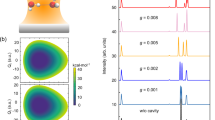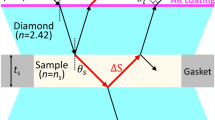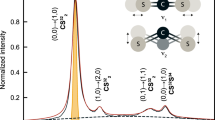Abstract
THE existence of dimers in water vapour at pressures approaching saturation has been postulated for some years and a number of observations have been interpreted in terms of them1–4. The relative dimer concentration is expected to increase sharply with increasing percentage saturation and decreasing temperature1,3. From speed of sound measurements, a dimer concentration of 8 parts per 103 has been reported at 50 °C and 90% saturation3; this might be expected to increase to >20‰ at 95% saturation and 20 °C. It may be supposed that the polarisability of the water dimer will be considerably larger than that of the monomer, and therefore, using an assumed value for polarisability, an estimate of the dimer concentration at a given temperature and vapour pressure can be made by comparing the quadratic term in a plot of the light scattered as a function of pressure with the known second virial coefficient. In early experiments, using a large multi-pass scattering cell, a very large quadratic term was observed. This arose, however, largely from a rapid increase in the elastic scattering from water-contaminated surfaces as the vapour pressure in the cell approached saturation. We have now eliminated this spurious scattering by selecting spectroscopically only those photons which exhibit a frequency shift due to Brillouin and Raman scattering.
This is a preview of subscription content, access via your institution
Access options
Subscribe to this journal
Receive 51 print issues and online access
$199.00 per year
only $3.90 per issue
Buy this article
- Purchase on SpringerLink
- Instant access to full article PDF
Prices may be subject to local taxes which are calculated during checkout
Similar content being viewed by others
References
Gebbie, H. A., Bohlander, R. A., and Pardoe, G. W. F., Nature, 230, 521 (1971).
Bohlander, R. A., Gebbie, H. A., and Pardoe, G. W. F., Nature, 228, 156 (1970).
Ashwell, G. E., Eggett, P. A., Emery, R., and Gebbie, H. A., Nature, 247, 196 (1974).
Bohlander, R. A., and Gebbie, H. A., Nature, 253, 523 (1975).
Pike, E. R., Pomeroy, W. R. M., and Vaughan, J. M., J. chem. Phys., 62, 3188 (1975).
Greytak, T. J., and Benedek, G. B., Phys. Rev. Lett, 17, 179 (1966).
Water, 1 (edit. by Franks, F.), 101 and 372 (Plenum, New York, London, 1972).
Author information
Authors and Affiliations
Rights and permissions
About this article
Cite this article
BURROWS, K., PIKE, E. & VAUGHAN, J. Light-scattering experiments on water Vapour at pressures approaching saturation. Nature 260, 131 (1976). https://doi.org/10.1038/260131a0
Received:
Accepted:
Issue date:
DOI: https://doi.org/10.1038/260131a0



